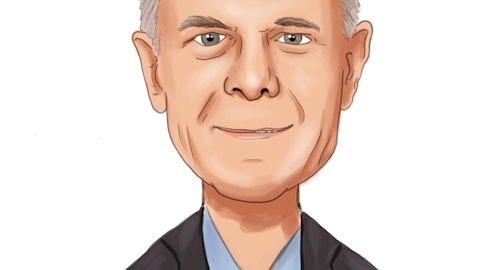Sara Zawoyski: Yes. So I think you’ve colored it in rather well, Julian. I mean, I think in terms of a price cost perspective, we do expect price to offset inflation, but to a narrower degree than what we saw in 2022, and some of that, again, was catch up, right, in terms of quarters past. And then productivity, while productivity embedded in that $290 million headwind, if you will, that was negative $65 million, with a balance of that being inflation. So we do expect that productivity to improve sequentially through the year. So not right at the gates here in Q1, but we continue to see good gradual improvement for supply chain, even from Q3 to Q4. We expect that to continue into Q1 and continue through the course of the year. So we see that a little bit more weighted towards productivity than price cost, but both contributing positively to that bar in 2023.
Julian Mitchell: Great. Thank you.
Operator: The next question is from Deane Dray from RBC Capital Markets. Please go ahead.
Deane Dray: Thank you. Good morning, everyone.
Beth Wozniak: Good morning.
Deane Dray: Sara, I was hoping you just take us through some of the dynamics in free cash flow, really strong finish to the year. How much was working capital at play? Did you take down buffer inventory? I know you referenced some of that for the 2023 free cash flow guide, but just take us through that, the working capital improvements, what happens to buffer inventory from here?
Sara Zawoyski: Yes. So we were really pleased with our free cash flow and working capital performance in Q4. And if you look at Q2 to Q3, that inventory was flat, even while sales grew. And then from Q3 to Q4, we did take down some of that inventory. And it really was reflective of some of the supply chain improvements we were seeing. So as we saw some a lead times come down, we were able to tighten up our own inventory. But still, I would say, it’s very surgical. But there’s — yes, there are still some areas that we’re not or where we want to be in our service levels, and know that we’ve got to make some of the some of those investments. So, we’re pleased with the progress we made during Q4. We know that there’s continued progress we can make as that supply chain improves, but we’re going to continue to take a very surgical approach to it to make sure that we’re also investing in those areas that we need to that are constrained or that have more challenging lead times.
Deane Dray: That’s helpful. And then for Beth. Can we get some more color on the data center solutions business. You are significantly outgrowing the market there. Can you give us a sense of how much of that is being driven by enclosures versus liquid cooling?
Beth Wozniak: When we look at that growth, I would say, in data solutions into two areas. One its our liquid cooling solutions. And when we do sell those off, and we’re selling those with racks and enclosures and fastening solutions, but we’ve talked about this before where liquid cooling is a more efficient way — energy efficient way of cooling data centers, and with data centers, and chips getting hotter, it’s really the direction that we’re seeing across all data center applications. So significant growth from liquid cooling. The other area, I would comment on where we saw growth is from our power distribution units. So as we think about how our growth outlook here, it really is all of what we do, but led predominantly by liquid cooling and our power distribution units. And that pulls through the rest of our enclosures and fastening solutions.
Deane Dray: That’s great. Thank you.
Operator: And the next question is from Jeff Hammond from KeyBanc. Please go ahead.
Jeff Hammond: Hey, good morning, everyone.
Beth Wozniak: Good morning.
Sara Zawoyski: Good morning.
Jeff Hammond: I just wanted to go back to the Enclosure margin. So very good in the quarter. I think Beth you said, that you would not expect that to repeat. So, I’m just wondering, if there were any aberrations or why that steps back? I know maybe there’s some seasonality, dynamics, et cetera. But just wondering on the sustainability there?
Sara Zawoyski: Yes. This is Sara. Maybe I’ll build upon what Beth said. I mean, in the quarter, right, from a Q4 perspective, some of that price was really catching up from the early part of the year. So Q1 and Q2 were cost exceeded price. And so, when we looked at Q4 stand alone, excellent, impressive return on sales. As you well know, usually, we have sort of a seasonal downtick in ROS, but that was very strong sort of quarter-to-quarter sequentially. So as we look at, maybe I’ll put in the context of the full year, we exited the year at 17% return on sales for enclosures. And we expect that from a full year perspective. And so, we would expect to build upon that and see the strongest margin expansion heading into 2023. And we would expect that first half sort of year-on-year margin expansion to be the strongest in comparison to the full year based on that price cost carryover.
So we do expect some nice margin performance here in quarter one year-over-year from a margin perspective.
Jeff Hammond: Okay. So it’s really, you had a big price cost catch up, and maybe that gap is a little bit smaller going forward?
Sara Zawoyski: Yes. Because comparing that, its kind of where thing stood in Q1 of year ago as well.





